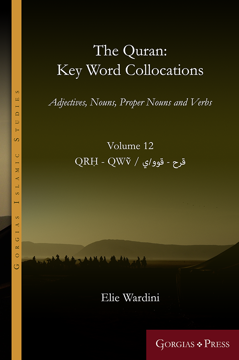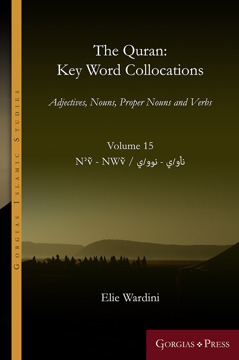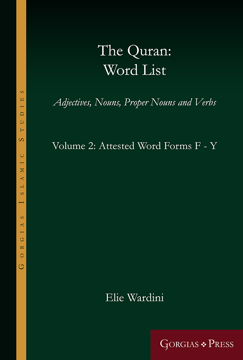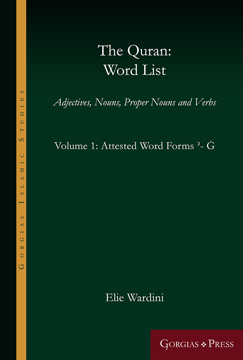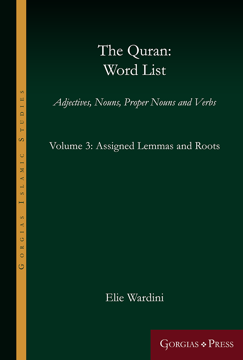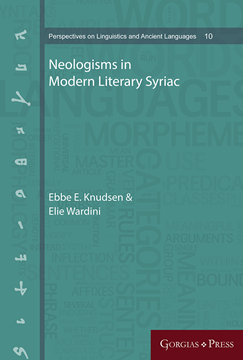Elie Wardini

Elie Wardini is professor of Arabic at Stockholm University, Sweden. His research has focused on Semitic languages, especially Aramaic-Arabic contact from a diachronic and sociolinguistic perspective.
Key Word Collocations (Volume 11)
Adjectives, Nouns, Proper Nouns and Verbs
By Elie Wardini
Series:
Gorgias Islamic Studies 15
ISBN:
978-1-4632-4317-3
The aim with the present series, The Quran: Key Word Collocations is to present the Quran as raw data with as little interpretation as possible. The digital text used for this purpose is the Uthmani text of the Tanzil Quran Text. In the present series, Collocation is defined as a Key Word, here adjectives, nouns, proper nouns and verbs, forming the center of a cluster with four co-occurring Key Words (1° and 2° of proximity), the first two to the left and to the right, where available. Every Collocation of each Key Word in the Quran is presented in context, as a rule with six words to the right and six to the left of it, where available or where the formatting permits. The central Key Words have been grouped by root > lemma. Classical dictionaries and Quran commentaries, as well as modern Quran dictionaries have been consulted.
$208.00 (USD)
Key Word Collocations (Volume 12)
Adjectives, Nouns, Proper Nouns and Verbs
By Elie Wardini
ISBN:
978-1-4632-4319-7
The aim with the present series, The Quran: Key Word Collocations is to present the Quran as raw data with as little interpretation as possible. The digital text used for this purpose is the Uthmani text of the Tanzil Quran Text. In the present series, Collocation is defined as a Key Word, here adjectives, nouns, proper nouns and verbs, forming the center of a cluster with four co-occurring Key Words (1° and 2° of proximity), the first two to the left and to the right, where available. Every Collocation of each Key Word in the Quran is presented in context, as a rule with six words to the right and six to the left of it, where available or where the formatting permits. The central Key Words have been grouped by root > lemma. Classical dictionaries and Quran commentaries, as well as modern Quran dictionaries have been consulted.
$189.00 (USD)
Key Word Collocations (Volume 13)
Adjectives, Nouns, Proper Nouns and Verbs
By Elie Wardini
Series:
Gorgias Islamic Studies 15
ISBN:
978-1-4632-4321-0
The aim with the present series, The Quran: Key Word Collocations is to present the Quran as raw data with as little interpretation as possible. The digital text used for this purpose is the Uthmani text of the Tanzil Quran Text. In the present series, Collocation is defined as a Key Word, here adjectives, nouns, proper nouns and verbs, forming the center of a cluster with four co-occurring Key Words (1° and 2° of proximity), the first two to the left and to the right, where available. Every Collocation of each Key Word in the Quran is presented in context, as a rule with six words to the right and six to the left of it, where available or where the formatting permits. The central Key Words have been grouped by root > lemma. Classical dictionaries and Quran commentaries, as well as modern Quran dictionaries have been consulted.
$212.00 (USD)
Key Word Collocations (Volume 14)
Adjectives, Nouns, Proper Nouns and Verbs
By Elie Wardini
Series:
Gorgias Islamic Studies 15
ISBN:
978-1-4632-4323-4
The aim with the present series, The Quran: Key Word Collocations is to present the Quran as raw data with as little interpretation as possible. The digital text used for this purpose is the Uthmani text of the Tanzil Quran Text. In the present series, Collocation is defined as a Key Word, here adjectives, nouns, proper nouns and verbs, forming the center of a cluster with four co-occurring Key Words (1° and 2° of proximity), the first two to the left and to the right, where available. Every Collocation of each Key Word in the Quran is presented in context, as a rule with six words to the right and six to the left of it, where available or where the formatting permits. The central Key Words have been grouped by root > lemma. Classical dictionaries and Quran commentaries, as well as modern Quran dictionaries have been consulted.
$183.00 (USD)
Key Word Collocations (Volume 15)
Adjectives, Nouns, Proper Nouns and Verbs
By Elie Wardini
Series:
Gorgias Islamic Studies 15
ISBN:
978-1-4632-4325-8
The aim with the present series, The Quran: Key Word Collocations is to present the Quran as raw data with as little interpretation as possible. The digital text used for this purpose is the Uthmani text of the Tanzil Quran Text. In the present series, Collocation is defined as a Key Word, here adjectives, nouns, proper nouns and verbs, forming the center of a cluster with four co-occurring Key Words (1° and 2° of proximity), the first two to the left and to the right, where available. Every Collocation of each Key Word in the Quran is presented in context, as a rule with six words to the right and six to the left of it, where available or where the formatting permits. The central Key Words have been grouped by root > lemma. Classical dictionaries and Quran commentaries, as well as modern Quran dictionaries have been consulted.
$199.00 (USD)
Key Word Collocations (Volume 16)
Adjectives, Nouns, Proper Nouns and Verbs
By Elie Wardini
Series:
Gorgias Islamic Studies 15
ISBN:
978-1-4632-4327-2
The aim with the present series, The Quran: Key Word Collocations is to present the Quran as raw data with as little interpretation as possible. The digital text used for this purpose is the Uthmani text of the Tanzil Quran Text. In the present series, Collocation is defined as a Key Word, here adjectives, nouns, proper nouns and verbs, forming the center of a cluster with four co-occurring Key Words (1° and 2° of proximity), the first two to the left and to the right, where available. Every Collocation of each Key Word in the Quran is presented in context, as a rule with six words to the right and six to the left of it, where available or where the formatting permits. The central Key Words have been grouped by root > lemma. Classical dictionaries and Quran commentaries, as well as modern Quran dictionaries have been consulted.
$216.00 (USD)
Word List (Volume 2)
Adjectives, Nouns, Proper Nouns and Verbs
By Elie Wardini
Series:
Gorgias Islamic Studies 14
ISBN:
978-1-4632-4175-9
The aim with the present series, The Quran: Word List, is to present every word form in the Quran as raw data with as little interpretation as possible. The digital text used for this purpose is the Uthmani text of the Tanzil Quran Text. In volumes one and two each attested word form in the Quran is listed alphabetically with no parsing and no alteration. These are listed by word form < lemma < root. Volume three consists of two sections. In section one, the lemmas assigned to each attested word form are listed. In section two, the assigned roots are listed. In assigning each word a root and lemma, Classical dictionaries and Quran commentaries, as well as modern Quran dictionaries have been consulted.
$149.00 (USD)
Word List (Volume 1)
Adjectives, Nouns, Proper Nouns and Verbs
By Elie Wardini
Series:
Gorgias Islamic Studies 14
ISBN:
978-1-4632-4173-5
The aim with the present series, The Quran: Word List, is to present every word form in the Quran as raw data with as little interpretation as possible. The digital text used for this purpose is the Uthmani text of the Tanzil Quran Text. In volumes one and two each attested word form in the Quran is listed alphabetically with no parsing and no alteration. These are listed by word form < lemma < root. Volume three consists of two sections. In section one, the lemmas assigned to each attested word form are listed. In section two, the assigned roots are listed. In assigning each word a root and lemma, Classical dictionaries and Quran commentaries, as well as modern Quran dictionaries have been consulted.
$149.00 (USD)
Word List (Volume 3)
Adjectives, Nouns, Proper Nouns and Verbs
By Elie Wardini
Series:
Gorgias Islamic Studies 14
ISBN:
978-1-4632-4177-3
The aim with the present series, The Quran: Word List, is to present every word form in the Quran as raw data with as little interpretation as possible. The digital text used for this purpose is the Uthmani text of the Tanzil Quran Text. In volumes one and two each attested word form in the Quran is listed alphabetically with no parsing and no alteration. These are listed by word form < lemma < root. Volume three consists of two sections. In section one, the lemmas assigned to each attested word form are listed. In section two, the assigned roots are listed. In assigning each word a root and lemma, Classical dictionaries and Quran commentaries, as well as modern Quran dictionaries have been consulted.
$123.00 (USD)
The Quran. Word List. 3 vols. - Bundle
ISBN:
978-1-4632-4179-7
This collection brings together the three volumes of Elie Wardini's The Quran: Word List. The aim of these volumes is to present the Quran as raw data with as little interpretation as possible. The digital text used for this purpose is the Uthmani text of the Tanzil Quran Text. In volumes one and two each attested word form in the Quran is listed alphabetically with no parsing and no alteration. These are listed by word form < lemma < root. Volume three consists of two sections. In section one, the lemmas assigned to each attested word form are listed. In section two, the assigned roots are listed. In assigning each word a root and lemma, Classical dictionaries and Quran commentaries, as well as modern Quran dictionaries have been consulted.
*Please note, no additional discounts apply to this bundle. The price quoted below is the lowest price.
$285.00 (USD)
Key Words in Context (Volume 1)
Adjectives, Nouns, Proper Nouns and Verbs
By Elie Wardini
Series:
Gorgias Islamic Studies 13
ISBN:
978-1-4632-4146-9
The aim with the present series, The Quran: Key Words in Context, is to present the Quran as raw data with as little interpretation as possible. The digital text used for this purpose is the Uthmani text of the Tanzil Quran Text. Each word in the Quran is presented in context, with five words to the right and left of it. In assigning each word a root and lemma, Classical dictionaries and Quran commentaries, as well as modern Quran dictionionaries have been consulted. Words have been grouped by root > verbal form > lemma. Verbs are quoted first (when attested), each followed by its associated nominal and/or adjectival derived forms.
$212.00 (USD)
Key Words in Context (Volume 2)
Adjectives, Nouns, Proper Nouns and Verbs
By Elie Wardini
Series:
Gorgias Islamic Studies 13
ISBN:
978-1-4632-4148-3
The aim with the present series, The Quran: Key Words in Context, is to present the Quran as raw data with as little interpretation as possible. The digital text used for this purpose is the Uthmani text of the Tanzil Quran Text. Each word in the Quran is presented in context, with five words to the right and left of it. In assigning each word a root and lemma, Classical dictionaries and Quran commentaries, as well as modern Quran dictionionaries have been consulted. Words have been grouped by root > verbal form > lemma. Verbs are quoted first (when attested), each followed by its associated nominal and/or adjectival derived forms.
$228.00 (USD)
Key Words in Context (Volume 3)
Adjectives, Nouns, Proper Nouns and Verbs
By Elie Wardini
Series:
Gorgias Islamic Studies 13
ISBN:
978-1-4632-4150-6
The aim with the present series, The Quran: Key Words in Context, is to present the Quran as raw data with as little interpretation as possible. The digital text used for this purpose is the Uthmani text of the Tanzil Quran Text. Each word in the Quran is presented in context, with five words to the right and left of it. In assigning each word a root and lemma, Classical dictionaries and Quran commentaries, as well as modern Quran dictionionaries have been consulted. Words have been grouped by root > verbal form > lemma. Verbs are quoted first (when attested), each followed by its associated nominal and/or adjectival derived forms.
$237.00 (USD)
Key Words in Context (Volume 4)
Adjectives, Nouns, Proper Nouns and Verbs
By Elie Wardini
Series:
Gorgias Islamic Studies 13
ISBN:
978-1-4632-4152-0
The aim with the present series, The Quran: Key Words in Context, is to present the Quran as raw data with as little interpretation as possible. The digital text used for this purpose is the Uthmani text of the Tanzil Quran Text. Each word in the Quran is presented in context, with five words to the right and left of it. In assigning each word a root and lemma, Classical dictionaries and Quran commentaries, as well as modern Quran dictionionaries have been consulted. Words have been grouped by root > verbal form > lemma. Verbs are quoted first (when attested), each followed by its associated nominal and/or adjectival derived forms.
$198.00 (USD)
Key Words in Context (Volume 5)
Adjectives, Nouns, Proper Nouns and Verbs
By Elie Wardini
Series:
Gorgias Islamic Studies 13
ISBN:
978-1-4632-4154-4
The aim with the present series, The Quran: Key Words in Context, is to present the Quran as raw data with as little interpretation as possible. The digital text used for this purpose is the Uthmani text of the Tanzil Quran Text. Each word in the Quran is presented in context, with five words to the right and left of it. In assigning each word a root and lemma, Classical dictionaries and Quran commentaries, as well as modern Quran dictionionaries have been consulted. Words have been grouped by root > verbal form > lemma. Verbs are quoted first (when attested), each followed by its associated nominal and/or adjectival derived forms.
$198.00 (USD)
Key Words in Context. 5 vols. - Bundle
ISBN:
978-1-4632-4169-8
This collection brings together the five volumes of Elie Wardini's The Quran: Key Words in Context. The aim of these volumes is to present the Quran as raw data with as little interpretation as possible. The digital text used for this purpose is the Uthmani text of the Tanzil Quran Text. Each word in the Quran is presented in context, with five words to the right and left of it. In assigning each word a root and lemma, Classical dictionaries and Quran commentaries, as well as modern Quran dictionionaries have been consulted. Words have been grouped by root > verbal form > lemma. Verbs are quoted first (when attested), each followed by its associated nominal and/or adjectival derived forms.
*Please note, no additional discounts apply to this bundle. The price quoted below is the lowest price.
$640.00 (USD)
Neologisms in Modern Literary Syriac
ISBN:
978-1-4632-3936-7
This book is the culmination of the Turabdin Project, the goal of which is to monitor the development of Modern Literary Syriac from the 1980s to the present. The approach is descriptive and contrastive relative to the Classical language, significant differences between Modern Literary Syriac and Classical Syriac are noted. The main focus is on neologisms and new developments in the lexicon.
$114.95 (USD)


